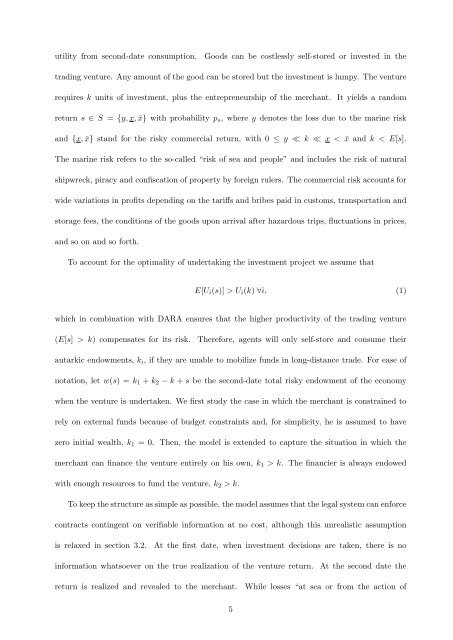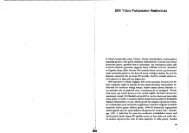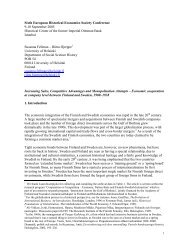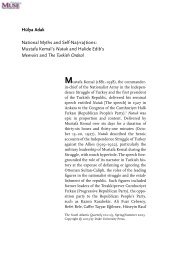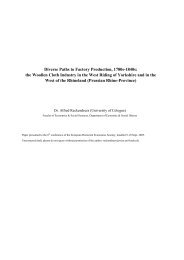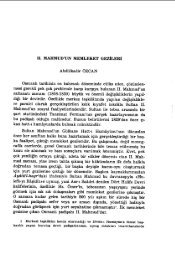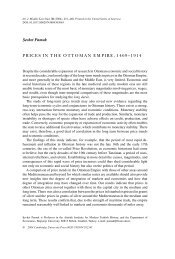The Birth of Insurance Contracts - The Ataturk Institute for Modern ...
The Birth of Insurance Contracts - The Ataturk Institute for Modern ...
The Birth of Insurance Contracts - The Ataturk Institute for Modern ...
You also want an ePaper? Increase the reach of your titles
YUMPU automatically turns print PDFs into web optimized ePapers that Google loves.
utility from second-date consumption. Goods can be costlessly self-stored or invested in the<br />
trading venture. Any amount <strong>of</strong> the good can be stored but the investment is lumpy. <strong>The</strong> venture<br />
requires k units <strong>of</strong> investment, plus the entrepreneurship <strong>of</strong> the merchant. It yields a random<br />
return s ∈ S = {y, x, ¯x} with probability ps, where y denotes the loss due to the marine risk<br />
and {x, ¯x} stand <strong>for</strong> the risky commercial return, with 0 ≤ y ≪ k ≪ x < ¯x and k < E[s].<br />
<strong>The</strong> marine risk refers to the so-called “risk <strong>of</strong> sea and people” and includes the risk <strong>of</strong> natural<br />
shipwreck, piracy and confiscation <strong>of</strong> property by <strong>for</strong>eign rulers. <strong>The</strong> commercial risk accounts <strong>for</strong><br />
wide variations in pr<strong>of</strong>its depending on the tariffs and bribes paid in customs, transportation and<br />
storage fees, the conditions <strong>of</strong> the goods upon arrival after hazardous trips, fluctuations in prices,<br />
and so on and so <strong>for</strong>th.<br />
To account <strong>for</strong> the optimality <strong>of</strong> undertaking the investment project we assume that<br />
E[Ui(s)] > Ui(k) ∀i, (1)<br />
which in combination with DARA ensures that the higher productivity <strong>of</strong> the trading venture<br />
(E[s] > k) compensates <strong>for</strong> its risk. <strong>The</strong>re<strong>for</strong>e, agents will only self-store and consume their<br />
autarkic endowments, ki, if they are unable to mobilize funds in long-distance trade. For ease <strong>of</strong><br />
notation, let w(s) = k1 + k2 − k + s be the second-date total risky endowment <strong>of</strong> the economy<br />
when the venture is undertaken. We first study the case in which the merchant is constrained to<br />
rely on external funds because <strong>of</strong> budget constraints and, <strong>for</strong> simplicity, he is assumed to have<br />
zero initial wealth, k1 = 0. <strong>The</strong>n, the model is extended to capture the situation in which the<br />
merchant can finance the venture entirely on his own, k1 > k. <strong>The</strong> financier is always endowed<br />
with enough resources to fund the venture, k2 > k.<br />
To keep the structure as simple as possible, the model assumes that the legal system can en<strong>for</strong>ce<br />
contracts contingent on verifiable in<strong>for</strong>mation at no cost, although this unrealistic assumption<br />
is relaxed in section 3.2. At the first date, when investment decisions are taken, there is no<br />
in<strong>for</strong>mation whatsoever on the true realization <strong>of</strong> the venture return. At the second date the<br />
return is realized and revealed to the merchant. While losses “at sea or from the action <strong>of</strong><br />
5


